

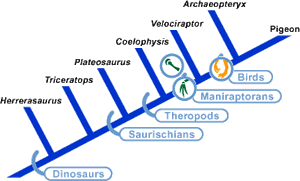



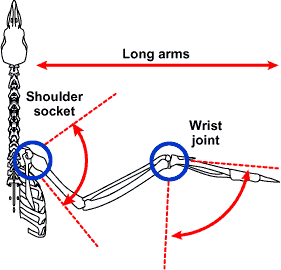
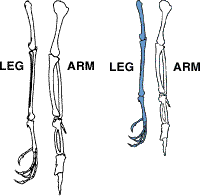
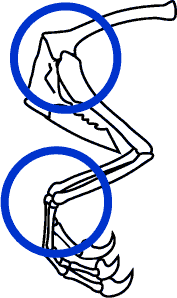
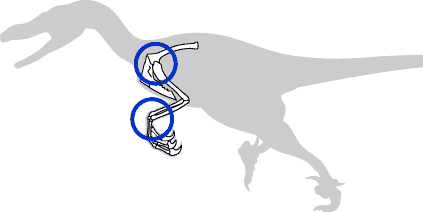

Question 1:
To generate both lift and thrust, a bird's wings must:
| be large enough to generate sufficient force. | |
| |
have a wide range of motion in the shoulder. |
| have a wide range of motion in the wrist. | |
| All of the above. | |
| None of the above. |
Question 2:
The relative length of arms compared to legs is important in flight because it indicates:
| a strong ability to run. | |
| the size of the wing relative to body weight. | |
| the strength of the wing and leg. | |
| the weight of the bird. | |
| All of the above. |
Question 3:
The increased range of motion in the shoulder and wrist:
| are important in the flight stroke. | |
| probably did not evolve until after flight. | |
| probably provided some advantage before flight evolved. | |
| A and B are correct. | |
| A and C are correct. |
Question 4:
Using the information shown in the cladogram, the increased range of motion necessary to develop a "flight stroke" first appeared in:
| all dinosaurs. | |
| the Saurischians. | |
| the Theropods. | |
| the Maniraptorans. | |
| All of the above. |
Think again about the many different features that make flight possible.
Not quite...Remember that arm length is indicative of wing size, and leg length is indicative of weight!
Remember that even Velociraptor had increased rotation in its shoulder and wrist. Try Again.
To generate both lift and thrust, a bird's wings must be large enough, and must have a wide range of motion in both shoulder and wrist.
Comparing relative arm and leg length is a rough indicator of the relationship between wing length and body weight, which is a key factor in flight.
The range of motion in the shoulder and wrist is important in the flight stroke, and probably provided an advantage before flight evolved.
Maniraptorans had the necessary skeletal features to allow the increased motion that led to an efficient "flight stroke."
That's it, let's tally your score!